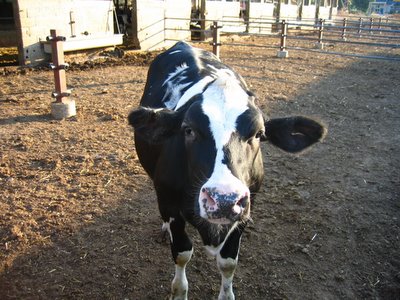
Last Sunday, I found myself in desolate Norwalk, CA, unlikely home to what may be L.A.'s last suburban dairy. Well over a hundred cows and dozens of very free-range chickens live in a vast mud field flanked by a mini-mall, an automotive salvage yard, and a very small, very old wooden house. Car parts, trailers, and assorted machines litter the property. It's hard to get answers at the Norwalk Dairy, but it looks like the final remnant of agriculture in a lower-middle-class suburb where property values never rose high enough to kick out the cows or keep out the junkyards.
Eight years ago, the flimsy shack out front was just a dairy outlet. When I stumbled on this place, way back when, I couldn't finish a half-pint of full-fat chocolate milk. It was thick as a shake, but without all those reassuring texturizers.
These days, the place is jammed with refrigerator cases full of soft drinks, shelves packed with snacks, and all the trappings of a scruffy convenience store. It took me a minute or two to locate the dairy's actual products -- unlabeled plastic half-gallons of the freshest milk for miles around, all lined up in a glass-fronted fridge behind the counter. You can't buy eggs from the local chickens though -- the dozens come from somewhere else.
For all the Lotto posters and celebrity magazines, it still smells like a dairy. A lot. It's a gloriously seedy surprise, simultaneously out of time, place, sight, and mind. Go visit the cows, and then, if you still have an appetite, stop at Renu Nakorn, the renowned Issan Thai restaurant just a few blocks west. You just might be in the mood for tofu.
Why Cows Are Mad

Adolescents: Not quite numb and numbered
Almost two months ago in Israel, I wrote a post about how agriculture turns cows, fish, and migrant workers into "robots," to use my farmer uncle's term. A new story on Haaretz.com, "More Milk Means More Udder Pain for Cows," addresses just how far off the rails Israeli dairy farmers have gone in their efforts to maximize milk production.
- "[C]owsheds have been transformed into an industry that causes suffering to all those involved in it: the cows, whose living conditions are dictated by factors of economic productivity; the Thai workers, who are usually employed in deplorable conditions; and the farm owners, hundreds of whom are on the verge of financial collapse."
You can see my photos of very young calves if you scroll down this page or click on the "Fish Cow Robot" link at left. Or you can just look at this little character, who's about the size of a large dog:

My uncle, who used to work in his kibbutz's dairy, was candid about how early the calves are separated from their mothers. But the article goes into detail:
- "When a calf is born, the mother is allowed to lick and clean it, but they are separated within 30 minutes to a few hours. Some dairy farmers testify that the separation is difficult on both the mother cows and their calves, based on the distressful cries of both animals. The calves continue to call for their mothers for hours after the separation. These separations are imposed because the calf's presence 'interrupts' the mother's milking routine, and 'wastes' milk. The calves are penned in wire isolation cages, where they are held for about two months."
And so on. I didn't mean to go all PETA here, but the 1300-word article lays bare the downside of an industry that on the one hand shows Israel's agri-ingenuity at its most agri-ingenious (see the article for how the eugenics are handled) and on the other hand has grown out of control.
- "Cows in Israel yield the largest quantity of milk in the world. In New Zealand, for instance, cows produce an average of about 3,450 liters of milk a year; in the European Union, cows give 6,450 liters a year; in the U.S., about 8,200 liters. Conversely, a single cow in Israel produces more than 10,000 liters of milk per year."
And yet,
- "Numerous studies in the U.S. and Europe have consistently shown that the frequency of udder inflammation, lameness and fertility problems increases in direct proportion to the increase of milk production. The genetic enhancement process comes at a cost to the health and well-being of the animal, since the body systems cannot withstand the burden of the intensive activity required by the augmented milk production...."
Note that the situation is not limited to Israel. American cows aren't far behind in their production numbers. It's a cheery piece all right ... and it doesn't even begin to address hormones, antibiotics, or bovine spongiform encephalitis. It's almost enough to make you give up dairy altogether.

*

No comments:
Post a Comment